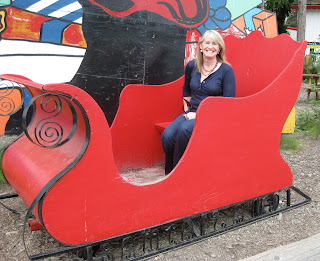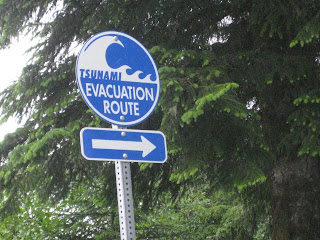So it was back to work at the National Park Service after my long weekend in Fairbanks, as Morgan, with whom I’d been working, was shipped out on assignment to help with media relations at the oil disaster at New Orleans, at the bottom of ‘the lower 48’. I’ve noticed Alaskans refer to the rest of America as ‘the lower 48’ with an air of friendly superiority! BP has a prominent presence in Anchorage including a sizeable high rise office block in midtown from where the company oversights oil and natural gas exploration and the operation of drilling rigs in the Cook Inlet and elsewhere interior in the state, with over 1500 local staff and a reported annual revenue of over $1billion!
The very sweet Jen from the Anchorage Fire Department ably stepped into Morgan’s role as Regional Fire Communicator and over the week I got on with the tasks left for me. The number of fires increased at first with thunderstorms and lightning sweeping across the state but eventually the wet weather that seemed to perpetually hang over Anchorage became more widespread and the fire season evaporated – or to be precise was virtually rained out - for the moment.
As the week progressed I had many fascinating conversations with people working in the regional office centring on the myriad differences (and similarities) between the park services and more particularly the systems and the politics and jobs and the parks.
After presenting a brown bag talk with lots of photos of our parks and operations back at home, I met Dave, an ex-park superintendent who now works in the regional office on sustainable subsistence. I learn from Dave that subsistence is a fascinating and controversial set of concepts here. For example, every man, woman and child who has lived in Alaska for over 12 months have fishing and hunting rights including a yearly allowance of around 10 salmon per head. Most people here are passionate about subsistence rights, especially about fishing, and collect their share. I say collect advisedly – as they routinely gear up and wade into rivers to use huge dip nets with 1.5m radius to catch the salmons.
Rivers are monitored as pulses of salmon make their final tortuous journey up-river to spawn. Fishing is opened up when salmon populations are considered adequate. The hapless salmon then run the gauntlet of a range of challenges. First they have to get past the commercial fishery at sea and at the river mouth where the greatest tonnage is harvested; then past urban Alaskans that stock freezers-full of fish for the year; then they have to get by subsistence communities that rely on salmon as a major part of their yearly diet - smoking and canning the fish to get them through the low productivity of the rural winter; and then to pass beyond the bears that need to get a decent feed of salmon to help fatten them up to see them through their winter hibernation! Not surprisingly, it has happened that not enough salmon make it back to the spawning grounds and the fishery collapses for that year.
Some salmon have to swim thousands of kilometres and across country borders to get back to their spawning grounds. It is hard to imagine how authorities can guarantee sustainability and it is a complex and vexed question as to how to share this precious wild harvest equitably.
Jen from work, and her husband Wade and two black labs, Hank and June-Bug invited me to stay for a couple of nights at the end of the week and we ate a delicious feed of salmon from their freezer and a salad I prepared (that my mate Tri would be proud of) on the second night. Brody, a friend of theirs dropped around and had us all in stitches as he regaled us all his mad adventures on the Hoka Hey – a crazy race across America, circuitously weaving from one end of the country to the other that finished in Alaska, riding only Harley Davidson motorbikes. The race decrees that participants must sleep with their bike and never be more than 40 feet from it at any time! Sadly 3 Hoka Hey contestants crashed and lost their life this year, probably from dozing while riding, as the gruelling race necessitates long days and rough sleeping takes its toll over the 2 – 3 weeks while the race is underway in earnest. Participants have to submit to a polygraph test and drug testing to claim the $500,000 purse – which by the way, is yet to be announced despite the race having been over in early July.
For the weekend I arranged to visit Cathy, who I met last month on the ferry from Ketchikan, in Homer for a few days. Arriving in Homer I found it to be an eclectic little coastal town nestled on the shore of glistening Kachemak Bay, with a stunning view of three glaciers and active volcanos off in the distance. A narrow spit pierces the bay like a curved filleting knife, and hangs on impossibly despite the punishment of tide and wind and wave. Fishing and arts characterise the resident population with scores of charter vessels and art galleries dotted along the spit as well as in town, providing ample opportunities for summer tourists to be parted from their cash.
Homer is well renown for halibut fishing; the halibut being a crazy looking flat fish from the flounder family. When it is young it looks like any normal fish but after 6 months one eye somehow migrates to the other side so both eyes are on top. They can grow to enormous proportions and specimens weighing 300 odd kilograms have been recorded but on average they are more like 12 kgs. The flesh of a halibut is white and sweet and all Alaskans love this fish as much as they love their salmon.
Cathy’s beautiful home sits neatly opposite the spectacular Grewingk Glacier (that I learn is actually shrinkingk) on Kachemak Bay and is a wonderful lodging to use as a base for exploring Homer. At the farmers markets we paused and listened to a great bluegrass band before heading to the annual street fair where exceptional local arts and crafts and were on offer. I spent a few hours in the Alaska Islands and Ocean Visitor Centre learning about the Kachemak Bay Research Reserve and the near-shore and watershed research underway there. I studiously visited all the galleries and craft shops before I reluctantly left and returned to Anchorage and the promise of week in the beautiful and remote Lake Clark National Park...


















